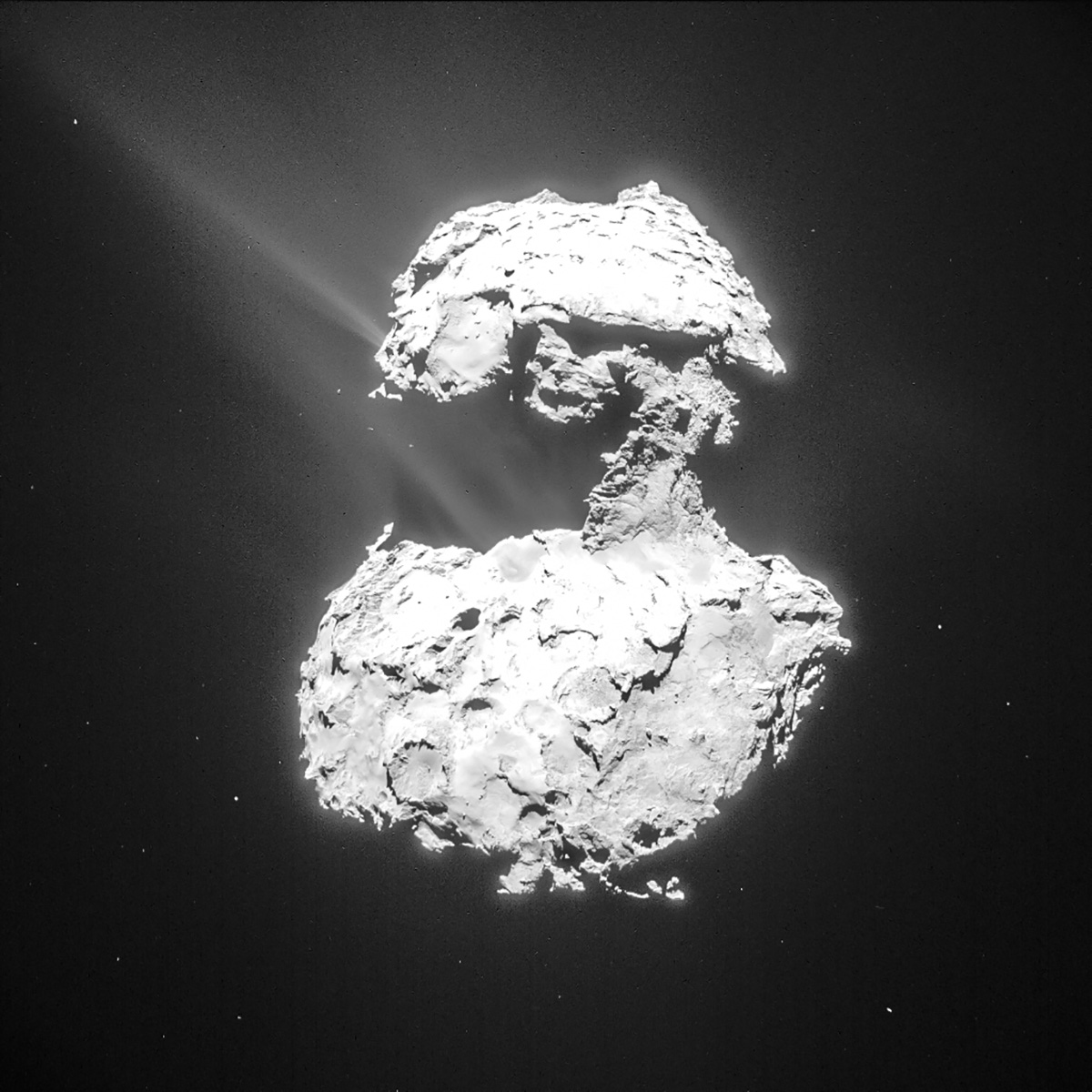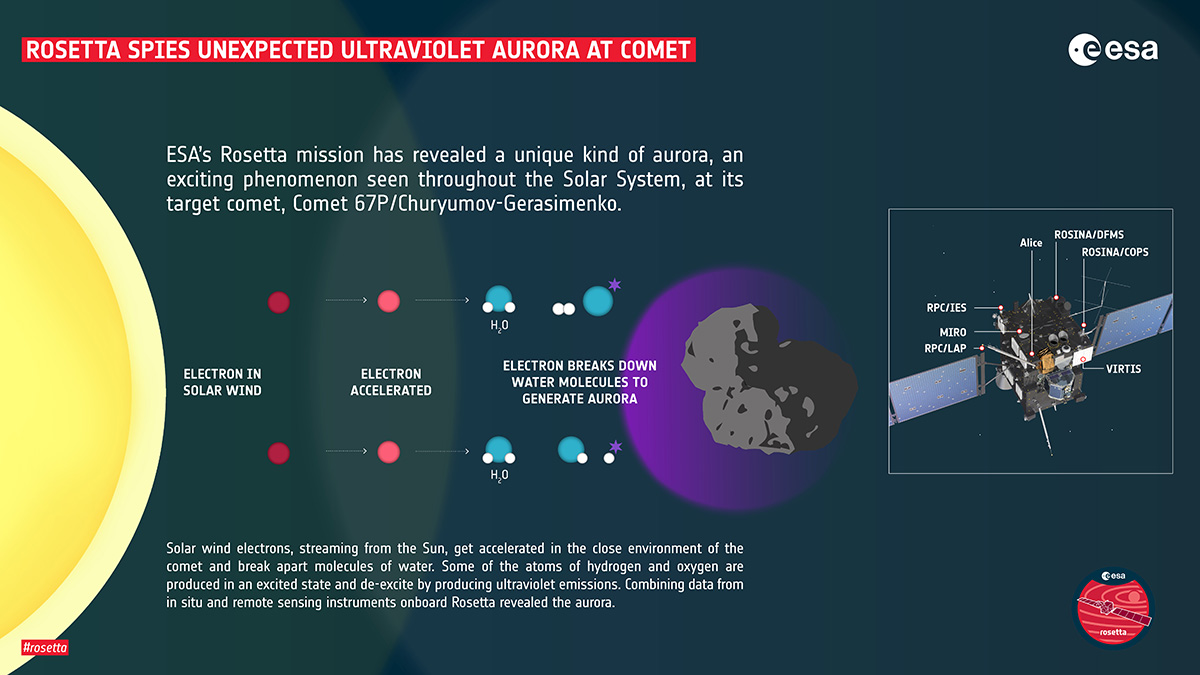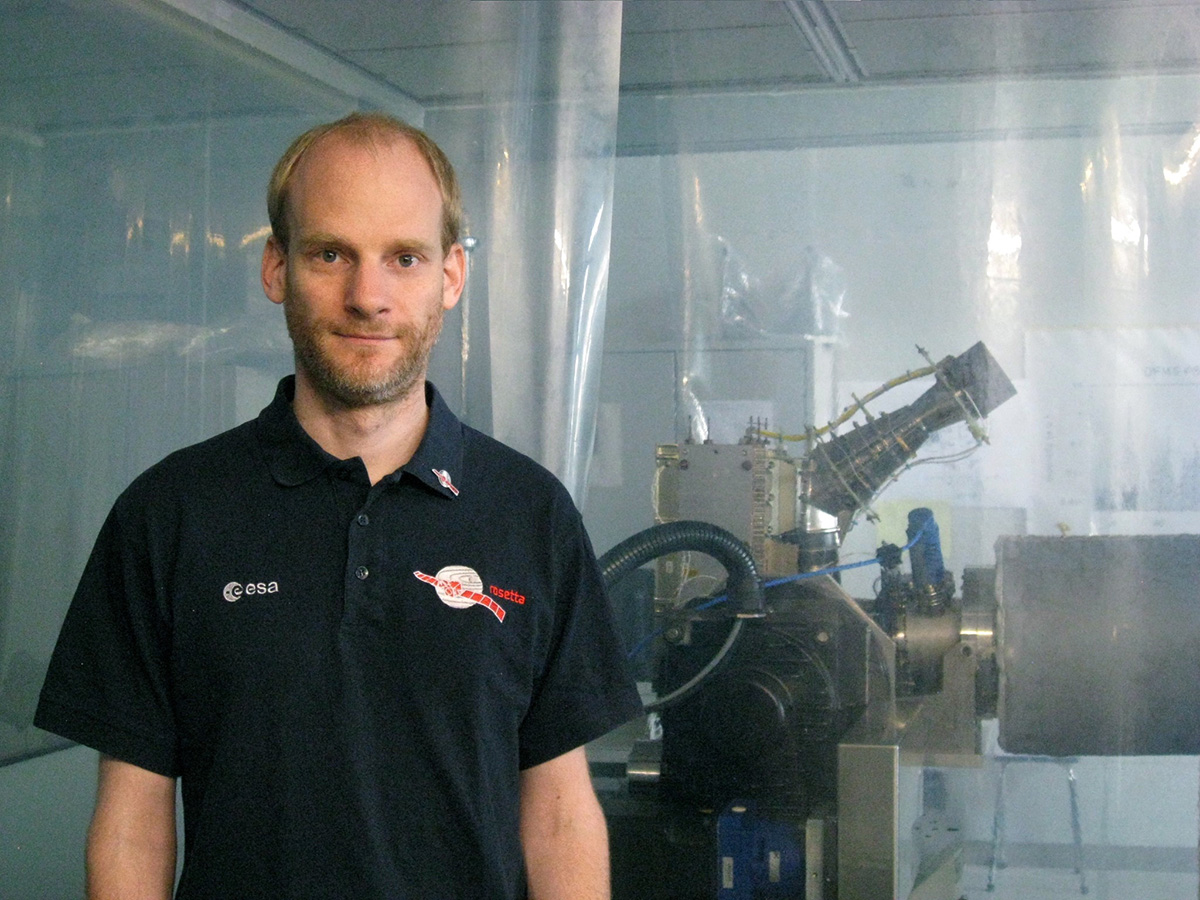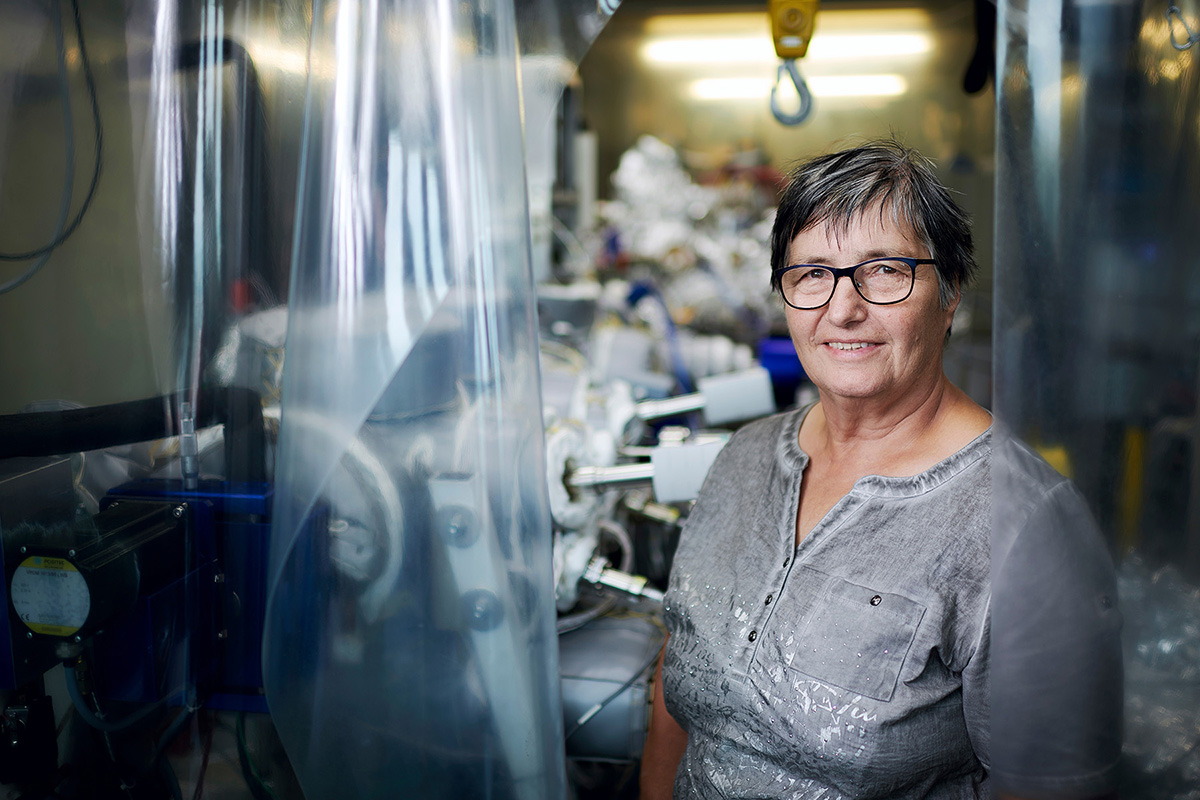Comet Chury's ultraviolet aurora
On Earth, auroras, also called northern lights, have always fascinated people. An international consortium involving the University of Bern has now discovered such auroras in the ultraviolet wavelength range at comet 67P/Churyumov-Gerasimenko, Chury for short. This phenomenon was detected thanks to the analysis of data from the European Space Agency ESA's Rosetta mission.
In the aurora borealis on Earth, electrically charged particles of the solar wind move along the Earth's magnetic field. At high latitudes, these strike nitrogen and oxygen atoms and molecules in the upper Earth's atmosphere and cause them to glow. These kinds of or similar aurora phenomena have also been discovered on other planets and their moons. As an international team reported today in the Nature Astronomy journal, the phenomenon has now been discovered at comet Chury. The solar wind's particles are responsible for the aurora at Chury as they strike the gas around the comet, also known as the coma. "The resulting glow is one of a kind," says Marina Galand of Imperial College London, lead author of the study. "It’s caused by a mix of processes, some seen at Jupiter's moons Ganymede and Europa and others at Earth and Mars."
Aurora observed in far ultraviolet light at a comet for the first time
Thanks to the analysis of data from the European Space Agency ESA's Rosetta mission, the researchers were able to prove that in the case of Chury solar wind electrons are accelerated towards the comet and strike the gas in the coma there. "Since this process is very high energy, the resulting glow is also highly energized and therefore in the ultraviolet range, which is invisible to the human eye," explains Martin Rubin, co-author of the study from the University of Bern Physics Institute.
These UV emissions had in fact been observed earlier at Chury. At that time though it was wrongly assumed that these emissions were caused by particles of sunlight, known as photons, similar to the so-called “nightglow” on Earth. "By analyzing the Rosetta data though, it was revealed that solar wind electrons are the reason for the glow and not in fact photons, as previously assumed," continues Galand.
"Rosetta is the first mission to observe an ultraviolet aurora at a comet," says Matt Taylor, ESA project scientist. "Auroras are inherently exciting – and this excitement is even greater when we see one somewhere new, or with new characteristics".
Data on gas composition from Bern
"The analysis was complicated and required data from various instruments," explains Kathrin Altwegg, head of ROSINA, the mass spectrometer at the University of Bern, which had collected data from comet Chury on board ESA's Rosetta space probe, providing information on the composition and density of the coma, among other things. According to Kathrin Altwegg, the study is evidence that our understanding can be deepened and new insights gained by using data from different teams, instruments and computer models. "And this even years after the official end of the mission in 2016 with the controlled crash of the Rosetta probe onto comet Chury's surface," continues Altwegg.
For the current study, Marina Galand and her team analyzed data from the Rosetta Orbiter Spectrometer for Ion and Neutral Gas Analysis (ROSINA) and the Alice UV spectrograph, Rosetta Plasma Consortium (RPC) Ion and Electron Spectrometer (IES) and the Langmuir Probe (LAP), the Microwave Instrument for the Rosetta Orbiter (MIRO) and the Visible and InfraRed Thermal Imaging Spectrometer (VIRTIS).
Aurora as a tool for observing the solar wind
Aurora phenomena are observed in the most diverse environments in our solar system and beyond. "A magnetic field like the one on Earth is not needed for this, as comet Chury does not have one itself," explains Martin Rubin. The aurora phenomenon at Chury is therefore more diffuse than on Earth. "The observation of cometary aurora phenomena definitely has an aesthetic value. Beyond that the UV observations from Earth could one day also provide information about the solar wind at these comets – even without a space probe like Rosetta being on site," explains Martin Rubin.
Information about the publication:M. Galand, P. D. Feldman, D. Bockelée-Morvan, N. Biver, Y.-C. Cheng, G. Rinaldi, M. Rubin, K. Altwegg, J. Deca, A. Beth, P. Stephenson, K. L. Heritier, P. Henri, J. Wm. Parker, C. Carr, A. I. Eriksson, J. Burch: Far ultraviolet aurora identified at comet 67P/Churyumov-Gerasimenko. Nature Astronomy, 21.09.2020. |
The European Space Agency ESAEurope has been active in space travel and space exploration since the start of the space age. The European Space Agency ESA, in which participating states pool and coordinate their activities, was founded in 1975. Switzerland was among the ten founding members of the ESA; today it comprises 22 member states. Bernese researchers were appointed to ESA’s advisory commissions very early on thanks to their proven expertise. Therefore, they also have an influence on which space projects and missions are chosen from the proposals submitted by the scientific community. The Rosetta missionThe mass spectrometer ROSINA was a key experiment of the Rosetta mission. For over two years, the Rosetta probe carried out a detailed examination of the comet 67P/Churyumov-Gerasimenko, called Chury for short, and in the course of this even landed a module on the surface of a comet for the first time ever. The mass spectrometer ROSINA (Rosetta Orbiter Spectrometer for Ion and Neutral Analysis) was developed, built, tested and telecommanded on the comet under the direction of the University of Bern. It was possible to determine many components of Chury’s atmosphere – many of which for the first time on a comet. Thus, ROSINA made a significant contribution to the acquisition of new insight into the origin of comets and hence our solar system. The mission’s active phase came to a close in 2016 with the Rosetta probe’s controlled crash on the surface of the comet Chury. However, since then, over 2 million data sets from ROSINA are still being evaluated in Bern and being made available to researchers across the world. |
Bernese space exploration: With the world’s elite since the first moon landingWhen the second man, "Buzz" Aldrin, stepped out of the lunar module on July 21, 1969, the first thing he did was to unfurl the Bernese solar wind sail and plant it into the ground on the moon, even before the American flag. This Solarwind Composition experiment (SWC) which was planned and analyzed by Prof. Dr. Johannes Geiss and his team from the Physics Institute of the University of Bern was the first great highlight in the history of Bernese space exploration. Bernese space exploration has been working with the world’s elite since then. The resulting numbers are impressive: Instruments flew into the upper atmosphere and ionosphere with rockets 25 times (1967-1993), 9 times into the stratosphere on balloon flights (1991-2008), over 30 instruments flew on space probes, and with CHEOPS the University of Bern shares responsibility with the ESA for a whole mission. The successful work of the Department of Space Research and Planetary Sciences (WP) from the Physics Institute of the University of Bern was consolidated by the foundation of a university competence center, the Center for Space and Habitability (CSH). The Swiss National Fund also awarded the University of Bern the national research focus (NFS) PlanetS , which it manages together with the University of Geneva. |
2020/09/21




